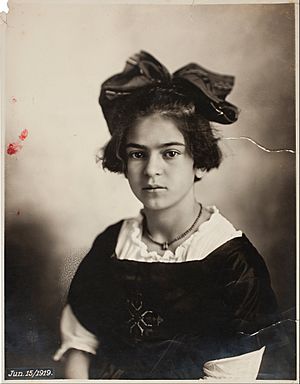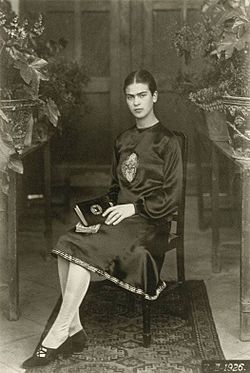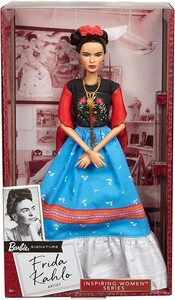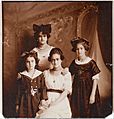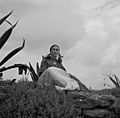Frida Kahlo facts for kids
Quick facts for kids
Frida Kahlo
|
|
|---|---|
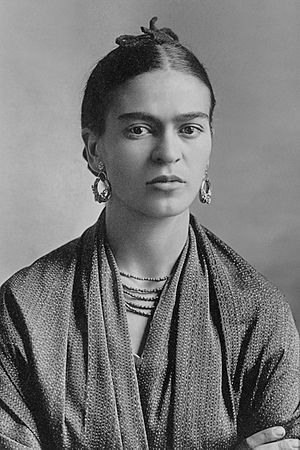
Kahlo in 1932
|
|
| Born |
Magdalena Carmen Frida Kahlo y Calderón
6 July 1907 Coyoacán, Mexico City, Mexico
|
| Died | 13 July 1954 (aged 47) Coyoacán, Mexico City, Mexico
|
| Other names | Magdalena Carmen Frieda Kahlo y Calderón, Frieda Kahlo |
| Education | Self-taught |
| Known for | Painting |
|
Works
|
|
| Movement |
|
| Spouse(s) |
(m. 1940) |
| Parents |
|
| Relatives | Cristina Kahlo (sister) |
| Signature | |
Magdalena Carmen Frida Kahlo y Calderón ( 6 July 1907 – 13 July 1954) was a Mexican painter known for her many portraits, self-portraits, and works inspired by the nature and artifacts of Mexico. Her paintings often had strong autobiographical elements and mixed realism with fantasy. She is also known for painting about her experience of chronic pain.
Contents
Early years
Born to a German father and a mestiza mother, Kahlo spent most of her childhood and adult life at La Casa Azul, her family home in Coyoacán – now publicly accessible as the Frida Kahlo Museum. Although she was disabled by polio as a child, Kahlo had been a promising student headed for medical school. Due to polio, Kahlo began school later than her peers. Along with her younger sister Cristina, she attended the local kindergarten and primary school in Coyoacán and was homeschooled for the fifth and sixth grades. While Cristina followed their sisters into a convent school, Kahlo was enrolled in a German school due to their father's wishes. She was soon expelled for disobedience.
Kahlo enjoyed art from an early age, receiving drawing instruction from printmaker Fernando Fernández (who was her father's friend) and filling notebooks with sketches.
A severe bus accident at the age of 18 left Kahlo in lifelong pain. Confined to bed for three months following the accident, Kahlo began to paint. She started to consider a career as a medical illustrator, as well, which would combine her interests in science and art.
Her mother provided her with a specially-made easel, which enabled her to paint in bed, and her father lent her some of his oil paints. She had a mirror placed above the easel, so that she could see herself. Painting became a way for Kahlo to explore questions of identity and existence. She explained, "I paint myself because I am often alone and I am the subject I know best." She later stated that the accident and the isolating recovery period made her desire "to begin again, painting things just as [she] saw them with [her] own eyes and nothing more."
Most of the paintings Kahlo made during this time were portraits of herself, her sisters, and her schoolfriends.
Artwork
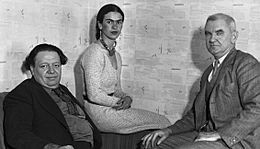
In 1925, Kahlo began to work to help her family. She became a paid engraving apprentice for Fernández. He was impressed by her talent, although she did not consider art as a career at this time.
Kahlo spent the late 1920s and early 1930s travelling in Mexico and the United States withe her husband and fellow Mexican artist Diego Rivera. During this time, she developed her artistic style, drawing her main inspiration from Mexican folk culture. She painted mostly small self-portraits that mixed elements from pre-Columbian and Catholic beliefs.
Her paintings raised the interest of surrealist artist André Breton, who arranged for Kahlo's first solo exhibition at the Julien Levy Gallery in New York in 1938; the exhibition was a success and was followed by another in Paris in 1939. While the French exhibition was less successful, the Louvre purchased a painting from Kahlo, The Frame, making her the first Mexican artist to be featured in their collection. Throughout the 1940s, Kahlo participated in exhibitions in Mexico and the United States and worked as an art teacher. She taught at the Escuela Nacional de Pintura, Escultura y Grabado ("La Esmeralda") and was a founding member of the Seminario de Cultura Mexicana. Kahlo's always-fragile health began to decline in the same decade. She had her first solo exhibition in Mexico in 1953, shortly before her death in 1954 at the age of 47.
Later years
Even as Kahlo was gaining recognition in Mexico, her health was declining rapidly, and an attempted surgery to support her spine failed. Her paintings from this period include Broken Column (1944), Without Hope (1945), Tree of Hope, Stand Fast (1946), and The Wounded Deer (1946), reflecting her poor physical state. During her last years, Kahlo was mostly confined to the Casa Azul. She painted mostly still lifes, portraying fruit and flowers with political symbols such as flags or doves.
Photographer Lola Alvarez Bravo understood that Kahlo did not have much longer to live, and thus staged her first solo exhibition in Mexico at the Galería Arte Contemporaneo in April 1953. Though Kahlo was initially not due to attend the opening, as her doctors had prescribed bed rest for her, she ordered her four-poster bed to be moved from her home to the gallery. To the surprise of the guests, she arrived in an ambulance and was carried on a stretcher to the bed, where she stayed for the duration of the party. The exhibition was a notable cultural event in Mexico and also received attention in mainstream press around the world. The same year, the Tate Gallery's exhibition on Mexican art in London featured five of her paintings.
In 1954, Kahlo was again hospitalized in April and May. That spring, she resumed painting after a one-year interval. Her last paintings include the political Marxism Will Give Health to the Sick (c. 1954) and Frida and Stalin (c. 1954) and the still-life Viva La Vida (1954).
Health issues and death
In 1950, Kahlo spent most of the year in Hospital ABC in Mexico City, where she underwent a new bone graft surgery on her spine. It caused a difficult infection and necessitated several follow-up surgeries. After being discharged, she was mostly confined to La Casa Azul, using a wheelchair and crutches to be ambulatory. During these final years of her life, Kahlo dedicated her time to political causes to the extent that her health allowed. She had rejoined the Mexican Communist Party in 1948 and campaigned for peace, for example, by collecting signatures for the Stockholm Appeal.
Kahlo's right leg was amputated at the knee due to gangrene in August 1953. She became severely depressed and anxious, and her dependency on painkillers escalated.
In her last days, Kahlo was mostly bedridden with bronchopneumonia, though she made a public appearance on 2 July 1954, participating with Rivera in a demonstration against the CIA invasion of Guatemala. She seemed to anticipate her death, as she spoke about it to visitors and drew skeletons and angels in her diary. The last drawing was a black angel, which biographer Hayden Herrera interprets as the Angel of Death. It was accompanied by the last words she wrote, "I joyfully await the exit – and I hope never to return – Frida" ("Espero Alegre la Salida – y Espero no Volver jamás").
The demonstration worsened her illness, and on the night of 12 July 1954, Kahlo had a high fever and was in extreme pain. At approximately 6 a.m. on 13 July 1954, her nurse found her dead in her bed. Kahlo was 47 years old. The official cause of death was pulmonary embolism, although no autopsy was performed.
On the evening of 13 July, Kahlo's body was taken to the Palacio de Bellas Artes, where it lay in state under a Communist flag. The following day, it was carried to the Panteón Civil de Dolores, where friends and family attended an informal funeral ceremony. Hundreds of admirers stood outside. In accordance with her wishes, Kahlo was cremated. Rivera, who stated that her death was "the most tragic day of my life", died three years later, in 1957. Kahlo's ashes are displayed in a pre-Columbian urn at La Casa Azul, which opened as a museum in 1958.
Recognition
Kahlo's work as an artist remained relatively unknown until the late 1970s, when her work was rediscovered by art historians and political activists. By the early 1990s, she had become a recognized figure in art history. She was also regarded as an icon for Chicanos, the feminism movement, and the LGBTQ+ community.
Kahlo's work has been celebrated internationally as emblematic of Mexican national and indigenous traditions.
Personal life
Kahlo's interests in politics and art led her to join the Mexican Communist Party in 1927, through which she met fellow Mexican artist Diego Rivera. The couple married in 1929. He was 42 and she was 22.
The couple divorced in 1939, but remarried December 8, 1940, in San Francisco, California. A year after Kahlo's death, on July 29, 1955, Rivera married Emma Hurtado, his agent since 1946.
Kahlo and Rivera had no children together.
Frida Kahlo quotes
- "They thought I was a Surrealist, but I wasn’t. I never painted dreams. I painted my own reality."
- "I paint flowers so they will not die."
- "At the end of the day, we can endure much more than we think we can."
- "Nothing is worth more than laughter."
- "The most important part of the body is the brain. Of my face, I like the eyebrows and eyes."
Interesting facts about Frida Kahlo
- Frida was born in Mexico, but her father was German.
- Her name was originally spelled "Frieda". "Friede" means "peace" in German.
- Frida survived both polio and a bus crash.
- She married a man with a name even longer than hers. Her husband's full name was Diego María de la Concepción Juan Nepomuceno Estanislao de la Rivera y Barrientos Acosta y Rodríguez.
- She exaggerated her facial hair in her self-portraits.
- Because of the bright clothing she wore, she was asked by children, "Where’s the circus?"
- She was born and died in the same house, called "La Casa Azul" (The Blue House), which is now known as Frida Kahlo Museum.
Commemorations
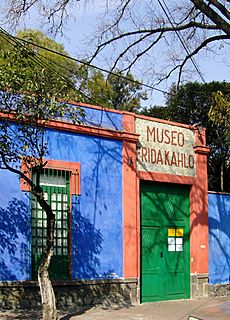
Kahlo's legacy has been commemorated in several ways:
- La Casa Azul, her home in Coyoacán, was opened as a museum in 1958, and has become one of the most popular museums in Mexico City, with approximately 25,000 visitors monthly.
- The city dedicated a park, Parque Frida Kahlo, to her in Coyoacán in 1985. The park features a bronze statue of Kahlo.
- In the United States, she became the first Hispanic woman to be honored with a U.S. postage stamp in 2001.
- She was inducted into the Legacy Walk, an outdoor public display in Chicago that celebrates LGBT history and people, in 2012.
- Kahlo received several commemorations on the centenary of her birth in 2007.
- Notable artists such as Marina Abramovic, Alana Archer, Gabriela Gonzalez Dellosso, Yasumasa Morimura, Cris Melo, Rupert Garcia, and others have used or appropriated Kahlo's imagery into their own works.
- Kahlo's life and art have inspired artists in various fields. Kahlo has also been the subject of several stage performances.
- In 2018, Mattel unveiled seventeen new Barbie dolls in celebration of International Women's Day, including one of Kahlo. Critics objected to the doll's slim waist and noticeably missing unibrow.
- In 2018, San Francisco Board of Supervisors unanimously voted to rename Phelan Avenue to Frida Kahlo Way. Frida Kahlo Way is the home of City College of San Francisco and Archbishop Riordan High School.
- In 2019, Frida was featured on a mural painted by Rafael Blanco in downtown Reno, Nevada.
- In 2019, Frida's “Fantasmones Siniestros” (“Sinister Ghosts”) was burned to ashes, publicizing an Ethereum NFT.
- In 2022, as part of a collaboration with Centre Pompidou, Swatch released a watch based on The Frame.
Solo exhibitions
- 4 January 2022 onwards Frida Kahlo: The Life of an Icon at Barangaroo Reserve, Sydney. Audio visual exhibition created by the Frida Kahlo Corporation.
- 8 February – 12 May 2019 – Frida Kahlo: Appearances Can Be Deceiving at the Brooklyn Museum. This was the largest U.S. exhibition in a decade devoted solely to the painter and the only U.S. show to feature her Tehuana clothing, hand-painted corsets and other never-before-seen items that had been locked away after the artist's death and rediscovered in 2004.
- 16 June – 18 November 2018 – Frida Kahlo: Making Her Self Up at the Victoria and Albert Museum in London. The basis for the later Brooklyn Museum exhibit.
- 3 February – 30 April 2016 – Frida Kahlo: Paintings and Graphic Art From Mexican Collections at the Faberge Museum, St. Petersburg. Russia's first retrospective of Kahlo's work.
- 27 October 2007 – 20 January 2008 – Frida Kahlo an exhibition at the Walker Art Center, Minneapolis, Philadelphia Museum of Art, 20 February – 18 May 2008; and the San Francisco Museum of Modern Art, 16 June – 28 September 2008.
- 1–15 November 1938 – Frida's first solo exhibit and New York debut at the Museum of Modern Art. Georgia O'Keeffe, Isamu Noguchi, and other prominent American artists attended the opening; approximately half of the paintings were sold.
Images for kids
-
Self-Portrait with Thorn Necklace and Hummingbird (1940), Harry Ransom Center
-
Kahlo with husband Diego Rivera in 1932
-
Frida photographed in 1932 by her father, Guillermo
-
1937 photograph by Toni Frissell, from a fashion shoot for Vogue
-
Effigy of Kahlo for Day of the Dead at the Museo Frida Kahlo
See also
 In Spanish: Frida Kahlo para niños
In Spanish: Frida Kahlo para niños


